Cambodian Temple Rising in South Seattle
Healing Cambodian Traumas from a Difficult Past
Written by: Jenny Chhim
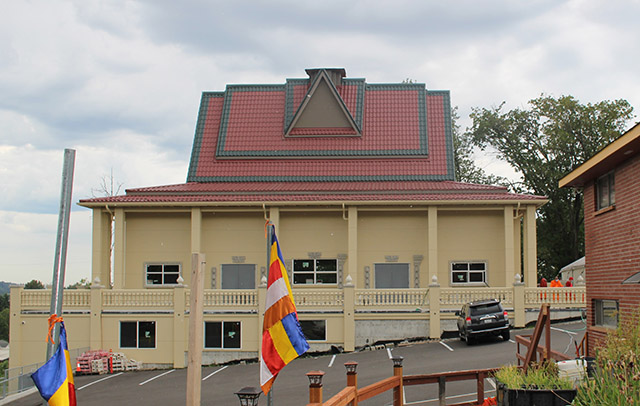
A view of the Preah Vihear from the south end of the property. It is under construction and not yet in use, with siding and roof installed.
Photos by: Ben Borkowski, Jenny Chhim, Prenz Sa-Ngoun
After years of planning and effort, the roofline of a traditional Cambodian Buddhist temple is rising in Seattle’s South Park neighborhood, overlooking the gritty industrial landscape around it.
The new temple will be the most prominent structure on the two-acre grounds of Wat Khemerak Pothiram, one of only two Cambodian Buddhist temples in the Seattle area. The other is Wat Dhammacakkaram on Seattle’s Beacon Hill.
The new structure at Wat Khemerak will be a formal Preah Vihear, a Cambodian term used to describe a place of religious worship and practice. The two-level structure when completed will be over 70 feet tall, covering about 5,000 square feet. It is the newest structure on the site, which also includes the original temple hall.
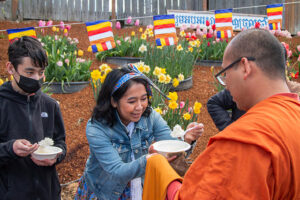
Wat Abbot Venerable Sok Theavy receives alms from author Jenny Chhim, and her son, Lengley, during Cambodian New Year 2022.
The hall’s architecture is a blend of traditional and modern styles set by leading Cambodian architect Vann Vollyman. The structure, colored primarily in deep maroon and gray, will be adorned with culturally significant Cambodian art forms known as kbach. These bas-relief sculptures are cast from traditional molds, and are replicas of those on the ancient temples of Bantey Srei in Siem Riep.
Temple leaders also are planning more sculptures and statues for the temple grounds, as well as three large golden stupas. These cone-like structures, overlooking the adjacent road, could house relics of realized masters, or urns containing ashes of community members.
The Preah Vihear will serve the community in many ways. It will feature a shrine hall on the main floor where monks will conduct religious ceremonies, and will also offer space for meditation.
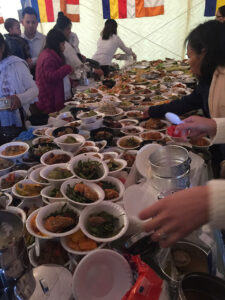
Lay people bring their best dishes to offer monks for the Cambodian New Year. Afterward, everyone shares!
The basement floor will include a library, and a more casual gathering space for non-ordained people. The grounds will also include a playground for the young, and housing for elders.
The temple started out as a humble house at this location in the mid 1990s. Through community generosity, and the persevering efforts of many volunteers and temple members, construction of the Preah Vihear began in 2012.
Temple members still use the original house as the main building. In addition, a temporary structure is erected for large crowds during special occasions, such as Cambodian New Year’s celebrations in April, when it is traditional for most Cambodian people to visit a temple.
Many who regularly attend services and volunteer at the temple are Cambodians who came to the Seattle area as refugees in the 1980s. They longed for a place where they could practice Buddhism in a setting similar to what they had known in their homeland, before war broke out in the mid-1970s.
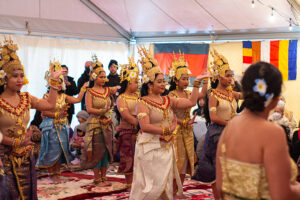
Cambodian Classical and Folk Dance Northwest dancers perform a traditional New Year’s dance, saved for future generations.
All services at Wat Khemarak Pothiram are conducted in the customary ways of Cambodian culture, to accommodate elders who primarily speak Cambodian. These elders make up the majority of temple visitors.
The five monks serving at the wat are all Cambodian born. Out of the five, only Venerable Sok Theavy fluently speaks English and gives dhamma talks in English.
Venerable Sok Theavy, 37, has been a monk since he was 8. He came to Wat Khemarak Pothiram in 2012, and his presence and English dhamma talks in English have been greatly appreciated among many American-born Cambodians, such as myself.
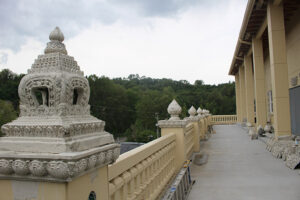
The southern terrace of the Preah Vihear adorned with lotuses on each post.
Buddhism was introduced to Cambodia in the 5th century, and continues as an integral part of Cambodian society to this day. However the practice of Buddhism was almost lost in 1975, when Cambodia fell under a brutal communist regime known as the Khmer Rouge, led by Pol Pot.
In just a few years, millions of Cambodians lost their lives due to starvation, intense labor, disease and executions. Most of the people targeted for execution were people who worked in government military, or anyone considered educated. The victims included Buddhist monks.
During this period many temples throughout the country were ravaged and used as labor camps and graveyards. Most of the historical Buddhist texts written on palm leaves were destroyed in the process.
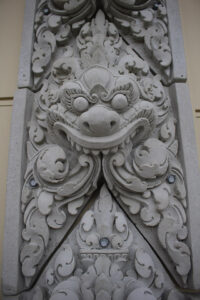
A traditional Cambodian bas relief depicting Kala, from Hindu mythology, of the type that will adorn the vihara.
Buddhism didn’t start to revive in Cambodia until the early 1990s, when a brave yet humble Cambodian monk, Preah Maha Ghosananda, began to visit Cambodian refugee camps in Thailand. The mere sight of him brought many people hope, and he would often recite suttas that were familiar and brought comfort to many.
Maha Ghosananda eventually led a peace walk, famously known as the Dhammayietra, during which he guided people from refugee camps back to their home villages, and eventually into Cambodia’s capital city of Phnom Penh. For this and related work he was several times nominated for a Nobel Peace Prize during the 1990s.
Maha Ghosananda’s work led him to the U.S. in the early 1990s, where he helped establish temples for the Cambodian community, leading to many other temples that followed afterward. Among these was Wat Khemarak Pothiram.
The generations born here in the United States, who are only fluent in English, are often confused about what happens at the temple. Due to our reverse language barriers, we often have a hard time understanding the Cambodian-language rituals and chanting during ceremonies.

The current shrine hall is inside this original home on the property.
People like myself, who became fluent in English as we grew up in the U.S., came to the temple as young children tagging along with our parents and grandparents. For younger generations of Cambodian Americans like us, the temple may be the only place, outside our homes, where we can connect with our cultural heritage .
The temple is where the Cambodian language is spoken, where the foods of our culture are served, where our art is displayed, where dance performances by local youth groups can be seen, and where our customs are followed. One such custom is to formally greet our elders with our palms together and our heads bowing toward them.
From a young age, we are taught the importance of honoring our ancestors. We spend holidays creating an altar in our home for them. We visit the temples to offer food, money, supplies, or to volunteer our time. We wish for our good actions to reach our ancestors and to help them along their path to nirvana.
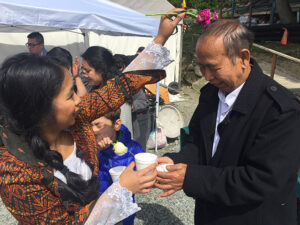
Chhim wishes her father a happy New Year, during the Sangran ceremony of Cambodian New Year.
It is when we begin reciting the Vandanā (salutations to the triple gem), Ti-Sarana (taking refuge in the triple gem), and Panca Sīla (reciting the five precepts) all done in Pali, that many of us younger-generation people sit with our elders and wonder what the words mean.
Although many of the younger generation of Cambodian Americans only come to the temple for the cultural experience, some of us are interested in learning about, and participating in, the spiritual practice of Buddhism. We are fortunate to live in a time when the dhamma is translated into many languages. Due to modern technology, as well as other outlets, we can connect to the dhamma faster than any other time in modern history.
Some elders have expressed fears the younger generation is beginning to lose interest in Buddhism, and along with it, interest in our Cambodian culture, But I beg to differ. There will always be a longing to know our history, and where we came from.
As long as the temple continues to connect us to our ancestral language, food, art, and customs, when the timing has ripened many of us will turn toward the sangha to discover our ancestral ties to Buddhism. The triple gem will be there, to help us make sense of the world we find ourselves living in.
Buddhism is part of the legacy of our ancestors. It is a jewel our ancestors have passed down from generation to generation for centuries. Wat Khemarak Pothiram is a testament to the resiliency of the Cambodian people, and to their relationship to Buddhism.
The Preah Vihear is a beacon of hope, that wherever Cambodians settle, there will always be a place we can call home. As the temple continues to develop and evolve, so will the people who come here for spiritual refuge.
Jenny Chhim, 37, is married with three children. She is the first of her family to be born in America, after her family fled the Khmer Rouge dictatorship in Cambodia in 1979, and arrived in the U.S. in 1984.
Chhim has attended Wat Khmerak Pothiram since she was a little girl. Her fond memories of visiting the temple as a child with her mother inspire her to participate in temple events. She visits Wat Khmerak Pothiram with her father weekly to offer alms, and often brings her children along. She continues studying the dhamma, and hopes to serve family and community in any way available.
